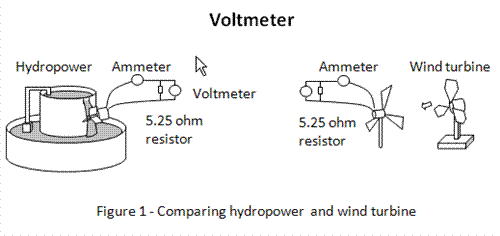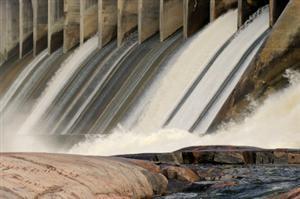| Complexity level: | 8 |
| Project cost ($): | 80 |
| Time required: | 1 day to prepare, 1 day for science fair project |
| Material availability: | Easily found |
| Safety concerns: | Basic safety requirements |
Hypothesis
Hydro power generation is more efficient than wind power generation.
Overview
Hydropower
Hydropower is energy that is derived from the flow of water downstream. Our planet's water cycle is such that rain falls in places of higher altitude. The rain water will possess more potential energy at a higher altitude. This energy will then be converted into kinetic energy as the water flows downstream into a river.
By building dams across rivers and using generators, we are able to convert the potential energy and kinetic energy in the water into electric power. This is an excellent source of renewable energy as it does not release any pollution into our environment. However, the building of dams required for the generation of electricity may result in a change in the direction that the river flows and alters the natural ecosystem. Wildlife and fish population are also affected by the building of dams.
Wind turbines
Wind energy is the power obtained from the wind using wind turbines or wind mills. Wind turbines produce electrical power while wind mills produce mechanical power. Wind farms are created with turbines located on towers that capture energy from the wind, covert it into electricity and supply it to a power grid. Wind turbines normally do not produce energy at speeds below 10mph and they are normally shut down at speeds above 50mph for safety reasons.
Scientific Terms
Materials
The materials required for this science fair project:
- A 15W fan
- A 15W water pump
- A dynamo fitted with blades
- A dynamo fitted with water wheel
- A pail
- A large basin
- tap water
- A knife
- A 5.25ohm resistor
- An ammeter
- A voltmeter
Procedure
1. For this science fair project, the independent variable is generating power by hydroelectric and wind turbine. The dependent variable is the amount of power generated. This is determined by measuring the voltage, ampere and calculating the power. The constants (control variables) are the load resistor, the dynamo used, the fan power and the water pump power.
2. To test for the rate of hydro power generation, the pail is placed inside the basin and both the pail and basin are filled with tap water as shown in figure 1 above. A small slot about the length of the water wheel is cut on top of the pail, to regulate the outflow of water.
3. The pump is placed in the basin and the outlet hose is positioned inside the pail. When the pump is turned on, the water will flow from the basin to the pail. The excess water will flow out of the pail through the slot back into the basin.
4. The dynamo fitted with the water wheel is positioned as shown in figure 1, so that the flowing water turns the wheel of the dynamo and produces electricity. The output of the dynamo is connected to a 5.25 ohm resistor. The output current and voltage of the dynamo is recorded in the table below.

5. To test for wind power generation, a dynamo fitted with blades is positioned in front of a 15W fan. When the fan is turned on, the wind causes the blades on the dynamo to turn and electricity will be produced. A 5.25 ohm resistor is connected across the dynamo terminal. The voltage and current are measured and recorded in the table given below.
6. The power produced by the dynamo is calculated as follows:
Output power (Watt) = Output Voltage x Output Current
7. The efficiency of the power generation :
Efficiency = Output Power (Watt) / Input Power (15 watts)

Results
The results showed that hydropower generation produced electric power more efficiently than wind power.
|
Power source |
Input power Pump/ Fan (W) |
Voltage (V) |
Ampere (A) |
Output Power (W) |
Efficiency % |
|
Hydro power |
15 |
6.3 |
1.2 |
7.56 |
50.4 |
|
Wind power |
15 |
4.3 |
0.8 |
3.36 |
22.4 |
Conclusion
The hypothesis that hydro power generation is more efficient than wind power generation, has been proven to be true.
Hydropower and wind power are replaceable energy sources that are clean and do not pollute our environment. Hydropower produces about 20% of the world's total power requirements. Since rainfall patterns are fairly predictable and rate of flow of rivers is also fairly constant, hydropower can be reliably produced. Wind change its speed and direction freqeuently. This makes it difficult for us to harvest wind energy efficiently. In a power grid, wind power generation is normally used together with other forms of energy generation.
Also consider
The science fair project can be repeated, this time, by varying the height of the pail or the distance of the turbine blade from the fan, to compare the energy produced.
Try to repeat the science project experiment by comparing the viability of other renewable sources of energy like solar power or wave power.
References
Hydropower facts - http://interestingenergyfacts.blogspot.com/2008/03/hydropower-facts.html
Wind power - http://en.wikipedia.org/wiki/Wind_power
Some facts about energy and wind power - http://www.blencathra.net/wind-power-facts.php

